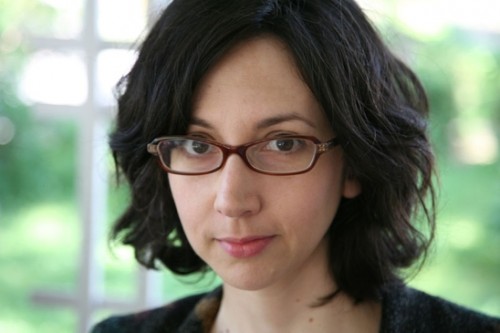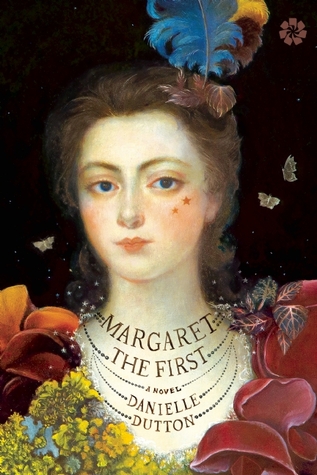It is a work of extraordinary emotional and psychological complexity, about a woman who locates salvation in her own creativity and is audacious enough to seek recognition in a world governed by men, from which it is not readily forthcoming. It is also a novel which plays with the line between confidence and egoism in a setting in which the slightest display of confidence on a woman’s part is too easily glossed as egoism — Natalie Helberg
Margaret the First: A Novel
Danielle Dutton
Catapult, 2016
Paper, 167 pages, $15.95
.
Danielle Dutton’s Margaret the First is a fictive recreation of the life of Lady Margaret Cavendish, a seventeenth-century word-smith, scripter, raging oddball, and wheeling brain. This was a woman who ventured to publish her outlandish thoughts and writings when there was very little precedent for acts of this kind (she was, after all, a woman, and constrained by the conventions which dogged her era). In some ways reminiscent of Virginia Woolf’s The Waves, Dutton’s book unfurls in prose which is arrestingly poetic; it concentrates on the small moments, emotions, and sensuous details which make up Margaret’s life, though without forgetting about the larger, less fleeting events which might be termed her life’s frame. It is a work in which colourful linguistic molecules reign, a work whose language is perhaps as excessive and stunning as Lady Cavendish’s own wardrobe was said to be.
It is also a work of extraordinary emotional and psychological complexity, about a woman who locates salvation in her own creativity and is audacious enough to seek recognition in a world governed by men, from which it is not readily forthcoming. It is a novel which plays with the line between confidence and egoism in a setting in which the slightest display of confidence on a woman’s part is too easily glossed as egoism (“Hadn’t I thoughts, after all?…It cannot be infamy, I reasoned, to run or seek after glory, to love perfection, desire praise…”; “I cannot be Henry the Fifth, or Charles the Second, yet I endeavour to be Margaret the First”). On another level, it is a novel about a woman being pushed along the line that is her life, a woman being buffeted about and subjected to forces she has no control over—wars, illness, her own body—while others, including loved ones, drop away: “In March, in London, my niece died from consumption. In April, my sister Mary. In Ireland that summer my brother Tom was crushed by his horse. The following autumn, our mother was taken…Alone in my room in Paris, I felt oblivion creep near.”
Margaret Cavendish, the character Dutton has fashioned, is at once bold and insecure, audacious and isolated (she is often more daring on the page than it is possible for her to be in person); even when she is all the rage (because her writing or eccentric attire is garnering attention) she is without community; she is by turns an object of praise, admiration, ridicule and resentment. The novel sweeps breathtakingly along from her birth to a noble family and early childhood in Colchester, England, to her death on a garden bench one winter’s morning. In between these events, the young Margaret Lucas serves the queen as a lady-in-waiting, marries William Cavendish, an aristocrat with no money but good connections (they dine and otherwise socialize with the best minds of the time: Hobbes, Descartes, Dryden, and others—all of whom more or less ignore Margaret), writes copiously (though she has her crises), and moves with him, in exile, from place to place: They are Royalists and the English Civil War is raging.
It is interesting to consider Margaret the First in light of Dutton’s other works. Dutton, who identifies as a writer of fiction, is nonetheless preoccupied with forms of narrative which resist the very distinction between poetry and prose. Neither her collection of short stories, Attempts at a Life, nor her first novel, SPRAWL, make use of conventional plot. Both are works which appear to let the sentence guide ‘what happens’ in the writing: the only rule seems to be that whatever comes next must be linguistically surprising, or refreshing. (Carla Harryman is another American prose-writer who works in something like this way, and Dutton is of course familiar with her.)
Today there’s no use for descriptions of the past. But life changes on a dial, in a garden, a clinking of beetle wings, a shrimp bush and dry pink petals of Chinese lanterns dangling. Once I thought: I’ll just plant things until there’s no time to be afraid. But storms are furious in their own way, green lightning and bullets as big as hail in the desert, as frogs.
My tongue reveals something faintly audible here. But birds come in off the low-slung roof and confess themselves atop cupboards. Even the occasional warm bird sandwich is prohibited. I spend a term untouched, living in an abandoned chophouse, pulling weeds. I post banns up and down the avenue, on palm trees and street signs. I drive a simple bargain. (“20C Pastoral” in Attempts at a Life)
Whereas Attempts at a Life consists of very short pieces which coalesce like poems (it is almost tempting to think of them as prose-poems), SPRAWL, whose structure is supposed to reinforce its theme, consists of a single, stream-of-consciousness-like paragraph whose sentences inventory the phenomena making up an equally sprawling suburbia:
We have a distinctive ecology involving cows, furniture, farms, real estate, azaleas, fires, corn, curtains, dust, passion, malefactors, milk, meat, cherries, wasps, mayors, pipefitters, fences… So we sit on the couch and drink cocktails with umbrellas and are strongly on this one side of taxation, with an emphasis on judges, unpleasant violent crime, serenity, the good life, biographies of famous leaders, science fiction, and marijuana. I say, “Thanks for coming.” Then I say, “Sakes alive!” then “Mendicant!”
Both books are textured, so to speak, like fiction, but the linguistic parts which make that texture up are allowed to sit next to each other in ways which are perhaps more mysterious than conventional fiction would allow (and how do the elements making up a poem fit together?—often they fit together illogically, which is to say: magically). In this vein, Dutton is an adept maker of lists. Many of her sentences, and paragraphs, too, assume the form of a list whose elements are motley enough to startle expectation, but coordinated enough to sustain a kind of sense overall. This kind of slightly discontinuous listing, if we can call it that, makes Dutton seem aesthetically close to Gertrude Stein, who is one of her acknowledged influences (Virginia Woolf and Georges Perec are others).
Margaret the First makes use of this technique as well, though the items which make up its various lists are slightly more coordinated than they are motley. This is perhaps because the novel, unlike Attempts at a Life, say, although it too is made up of short, poetically-cohering sections, strives to transcend its parts to sustain a longer, unified story. In this respect it is like Dutton’s first novel, though Margaret the First labours under an even greater constraint than the rather open-ended SPRAWL, since, however fictionalized it is, it is about a specific historical figure, whose life it promises to animate. ‘The list’ serves precisely this end; its recurring presence is one of the reasons the book’s prose is so sumptuous, and the world it conveys so vivid. It is also one of the reasons the mundane details of Margaret’s life become entirely engrossing:
One morning that June, I took only a conserve of marigold for breakfast, trying to loosen a cough, and, after wandering the halls, went to the garden with two hard plums in my pocket. I ate; the church bell tolled. Eventually, in petal-flecked shoes, I found my way to the sitting room, where my mother dozed and John’s pregnant wife stood absently by the settle. The room was remarkably hot, for Mother believed in keeping windows shut, and a fat summer fly bumped against the glass. I stood at a table fiddling with a vase. I counted thirty-seven stems and dreamt up a ruby coat for a Chinese empress, a watery dress for Ophelia, a series of towering crystalline hats that rattled, sparkled, and shook—until from the hall came a series of noises.
The kind of writing fictionalized Lady Cavendish does appears in the novel, too. It is also described. At times, it almost seems as if lodged in Dutton’s book is a poetic—a theoretical articulation of a writing practice (Cavendish’s)—which exceeds the poetic the book itself (that is, Dutton’s) partakes in. This poetic is presented in a positive light, as if it is radical and desirable, fully endorsed, even loved. Perhaps it is loved all the more because it does not speak to the novel’s actual style; instead, it is held at a distance, a condition for eros:
Margaret writes everything: poetry, plays, essays, fancies, alternative philosophy. The structure of many of her texts is chaotic, directionless (“just a jumble of speeches and scenes” without structure—though, of course, even a mess has structure: life’s chaos is structured, and Margaret wishes her texts would unfold “like the natural course of things”). Her writing also embraces hybridity (she produces a book which is both fictional and theoretical, both fanciful and philosophical, for example), and switches styles on a whim (“Might not language be as a closet full of gowns?”). It disregards grammatical requirements as well, mainly because Margaret is unfamiliar with them, but refuses to be held back. In a word, her text is wild. It is as wild as she is inexorable. It cuts what seems like it must be an impossible figure of freedom, but which is precisely not impossible: We could say that in Dutton’s novel lies an unformulated manifesto for writing, which in principle, but so rarely in practice, is open to every possibility.
Margaret’s theoretical thinking, too, is feral and fantastical. She disapproves of many of the scientific trends of her day (including experimentation on animals) and produces, we can gather from certain snippets, a kind of alternative metaphysics (which reads like a ‘pataphysical critique): “I rejected any clock-like vision of the world. I chastised men who hunt for sport. The moon might be a ball of water…” When she is finally able to attend one of the Royal Society’s meetings (she has to nudge, but she does get in), she is silent however. Internally, she is enraged; externally, she is docile. “Gentleman,” she says disingenuously, “I am all admiration.” Later, she tells her husband that the meeting was only “more chatter,” and we are given a fuller idea of her own sense of impotence; her docility, her agreeableness at the meeting, was just a throwing up of arms; her speech was the silence of one whose speech is dictated, of one who is trapped or cornered, of one whose genuine thoughts, if they do not provoke violence, will fall on deaf ears, of one who is alone in the world, while the rest of the world bears down.
Psychologically acute moments like this, subtle emotional swivels, rather than action per se, give this narrative shape and depth. The single constant Margaret has in the world, besides her writing, is her husband, William, but even her relationship with him sours and sweetens. He is initially supportive of her writing, even proud, going so far as to distribute copies of it to his eminent friends, but he becomes peevish later on (at one point he even tells her—more or less—that women should be seen and not heard). She does not help matters, either: for all her shyness, she is a shameless self-promoter, and is perhaps too preoccupied with her own doings to realize when she is stepping on his toes: She attends the opening night for a play he has written with her breasts bared and nipples painted—something of a fashion experiment, which is much noted during the performance. “Congratulations,” she tells him afterwards. “No, no,” he says, “Congratulations to you.”
Lady Cavendish is undoubtedly a complex, perhaps even contradictory, character: she is a character one for the most part sympathizes with, though she has it in her to be mortifying. She is an awkward character, to put this another way: both very public and extraordinarily private. The text holds a part of her in reserve, or seems to refrain from disclosing her fully. She wonders if William has forgiven her after the play-incident, but we are given little other insight into her anxiety: we know enough to know it is there; we know enough to know she suffers; still, these things are cloaked with silence. Dutton’s striking novel has its own way of wrapping things in silence: it leaves us with a winter’s tomb after giving us page after page ashake with leaves and petals, orations and courtships, wars and corpses, air pumps and eldritch grammars, seas and sciences, itinerancy and gossip, plums and manuscripts, ups and downs, birds and debt, kings and crates, fancies and Fox-men, wit and infertility, stupor and chewed goose, poems and autumn roses, Spanish stews and steady love. Its energy is inimitable; its curious aura—its curious beauty—burns a long while.
— Natalie Helberg
NC
Natalie Helberg completed an MFA in Creative Writing with the University of Guelph in 2013. She is currently studying philosophy at the University of Toronto. Some of her experimental work has appeared on InfluencySalon.ca and in Canadian Literature. She recently won The Capilano Review’s Fifth Annual Robin Blaser Award for poetry. She is (still) working on a hybrid novel.
.
.


